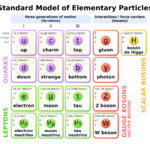Physics:Weak isospin
| Flavour in particle physics |
|---|
| Flavour quantum numbers |
|
| Related quantum numbers |
|
| Combinations |
|
| Flavour mixing |
In particle physics, weak isospin is a quantum number relating to the electrically charged part of the weak interaction: Particles with half-integer weak isospin can interact with the W± bosons; particles with zero weak isospin do not.[lower-alpha 1] Weak isospin is a construct parallel to the idea of isospin under the strong interaction. Weak isospin is usually given the symbol T or I, with the third component written as T3 or I3.[lower-alpha 2] It can be understood as the eigenvalue of a charge operator.
T3 is more important than T; typically "weak isospin" is used as short form of the proper term "3rd component of weak isospin".
The weak isospin conservation law relates to the conservation of weak interactions conserve T3. It is also conserved by the electromagnetic and strong interactions. However, interaction with the Higgs field does not conserve T3, as directly seen by propagation of fermions, mixing chiralities by dint of their mass terms resulting from their Higgs couplings. Since the Higgs field vacuum expectation value is nonzero, particles interact with this field all the time even in vacuum. Interaction with the Higgs field changes particles' weak isospin (and weak hypercharge). Only a specific combination of them, (electric charge), is conserved.
Relation with chirality
Fermions with negative chirality (also called "left-handed" fermions) have and can be grouped into doublets with that behave the same way under the weak interaction. By convention, electrically charged fermions are assigned with the same sign as their electric charge.[lower-alpha 3] For example, up-type quarks (u, c, t) have and always transform into down-type quarks (d, s, b), which have and vice versa. On the other hand, a quark never decays weakly into a quark of the same Something similar happens with left-handed leptons, which exist as doublets containing a charged lepton (Electron-, Muon-, Tau-) with and a neutrino (Electron neutrino, Muon neutrino, Tau neutrino) with In all cases, the corresponding anti-fermion has reversed chirality ("right-handed" antifermion) and reversed sign
Fermions with positive chirality ("right-handed" fermions) and anti-fermions with negative chirality ("left-handed" anti-fermions) have and form singlets that do not undergo charged weak interactions.[lower-alpha 4]
The electric charge, is related to weak isospin, and weak hypercharge, by
| Generation 1 | Generation 2 | Generation 3 | ||||||
|---|---|---|---|---|---|---|---|---|
| Fermion | Symbol | Weak isospin |
Fermion | Symbol | Weak isospin |
Fermion | Symbol | Weak isospin |
| Electron neutrino | Muon neutrino | Tau neutrino | ||||||
| Electron | Muon | Tauon | ||||||
| Up quark | Charm quark | Top quark | ||||||
| Down quark | Strange quark | Bottom quark | ||||||
| All of the above left-handed (regular) particles have corresponding right-handed anti-particles with equal and opposite weak isospin. | ||||||||
| All right-handed (regular) particles and left-handed anti-particles have weak isospin of 0. | ||||||||
Weak isospin and the W bosons
The symmetry associated with weak isospin is SU(2) and requires gauge bosons with ( W+ , W− , and W0 ) to mediate transformations between fermions with half-integer weak isospin charges. [2] implies that W bosons have three different values of
- W+ boson is emitted in transitions →
- W0 boson would be emitted in weak interactions where does not change, such as neutrino scattering.
- W− boson is emitted in transitions → .
Under electroweak unification, the W0 boson mixes with the weak hypercharge gauge boson B0 ; both have weak isospin = 0 . This results in the observed Z boson0 boson and the photon of quantum electrodynamics; the resulting Z boson0 and photon0 likewise have zero weak isospin.
The sum of negative isospin and positive charge is zero for each of the bosons, consequently, all the electroweak bosons have weak hypercharge so unlike gluons of the color force, the electroweak bosons are unaffected by the force they mediate.
See also
Footnotes
- ↑ Interaction with the Z boson0 is only related indirectly; its interaction is determined by weak charge, q.v.
- ↑
This article uses T and T3 for weak isospin and its projection.
- ↑ Lacking any distinguishing electric charge, neutrinos and antineutrinos are assigned the opposite their corresponding charged lepton; hence, all left-handed neutrinos are paired with negatively charged left-handed leptons with so those neutrinos have Since right-handed antineutrinos are paired with positively charged right-handed anti-leptons with those antineutrinos are assigned The same result follows from particle-antiparticle charge & parity reversal, between left-handed neutrinos () and right-handed antineutrinos ().
- ↑ Particles with do not interact with W± bosons; however, they do all interact with the Z boson0 boson, with the possible exception of hypothetical sterile neutrinos not yet included in the Standard Model. If they actually exist, sterile neutrinos would become the only elementary fermions in the Standard Model that do not interact with the Z boson0 boson.
References
- ↑
"The algebra of Grand Unified Theories". Bulletin of the American Mathematical Society 47 (3): 483–552. 2010. doi:10.1090/s0273-0979-10-01294-2. Bibcode: 2009arXiv0904.1556B.
- ↑ An introduction to quantum field theory, by M.E. Peskin and D.V. Schroeder (HarperCollins, 1995) ISBN:0-201-50397-2; Gauge theory of elementary particle physics, by T.P. Cheng and L.F. Li (Oxford University Press, 1982) ISBN:0-19-851961-3; The quantum theory of fields (vol 2), by S. Weinberg (Cambridge University Press, 1996) ISBN:0-521-55002-5.
he:איזוספין חלש
 |


